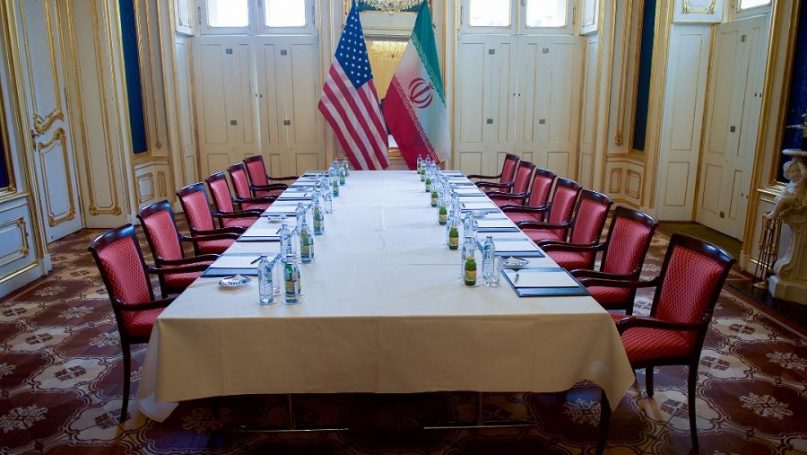 Immediately after the first gulf war in the early 1990’s the theories of Revolution in Military Affairs (RMA) and Information Warfare were being studied all over the world as a new kind of warfare. During that time, a course on Information Warfare was conducted at the National Defense University of USA. The course participants were from senior officers of the armed forces, representatives of Department of Defence and Department of State and policy makers from the government. Rand Corporation of US was conducting this course. Continue reading.......
Immediately after the first gulf war in the early 1990’s the theories of Revolution in Military Affairs (RMA) and Information Warfare were being studied all over the world as a new kind of warfare. During that time, a course on Information Warfare was conducted at the National Defense University of USA. The course participants were from senior officers of the armed forces, representatives of Department of Defence and Department of State and policy makers from the government. Rand Corporation of US was conducting this course. Continue reading.......15 July 2020
Cyber Wargame - An Indian Scenario
 Immediately after the first gulf war in the early 1990’s the theories of Revolution in Military Affairs (RMA) and Information Warfare were being studied all over the world as a new kind of warfare. During that time, a course on Information Warfare was conducted at the National Defense University of USA. The course participants were from senior officers of the armed forces, representatives of Department of Defence and Department of State and policy makers from the government. Rand Corporation of US was conducting this course. Continue reading.......
Immediately after the first gulf war in the early 1990’s the theories of Revolution in Military Affairs (RMA) and Information Warfare were being studied all over the world as a new kind of warfare. During that time, a course on Information Warfare was conducted at the National Defense University of USA. The course participants were from senior officers of the armed forces, representatives of Department of Defence and Department of State and policy makers from the government. Rand Corporation of US was conducting this course. Continue reading.......India In The Balance – Analysis
By Marvin C. Ott*
(FPRI) — The uneasy relationship between India and China took a sudden turn for the worse in June. With no apparent warning, a violent clash broke out between Indian and Chinese troops manning a remote section of disputed border in the Himalayas. Because a prior agreement barred firearms in the area, the fighting was conducted with the most primitive of weapons: stones, clubs, iron bars, and bare hands. The sheer intensity of what resembled a “gang war” was evident from the fact that 20 Indian soldiers were killed. Chinese casualties reportedly numbered even more (76 by one count). This is the first time in 45 years that the armed forces of the two countries have actually fought, but that doesn’t mean there haven’t been tensions—far from it.
India and China are in many ways remarkably comparable. They both are huge in size with populations that number around 1.3 billion. Both are heirs to great civilizations that trace their origins back millennia. Both suffered profound humiliations at the hand of the West, including British colonial rule over India and imperial breakdown and semi-colonization of China at the hands of several Western powers led by Britain. Both emerged in their modern form after World War II. India became independent in 1947 and Mao’s People’s Republic triumphed in 1949. They share one of the world’s longest borders—traversing the Himalayas.
In Pakistan, the Army Tightens Its Grip
Pakistan has faced an unprecedented set of challenges this year—from a locust invasion that threatened to infest 40 percent of the agrarian economy’s major crops to a pandemic that brought business activity to a grinding halt, prompting layoffs, falling household incomes, and a decline in purchasing power.
But when Prime Minister Imran Khan’s administration unveiled the federal budget for the fiscal year 2020-2021 last month, a response to those calamities was nowhere to be seen. The budget allocated 1.29 trillion rupees ($7.7 billion) to defense expenditure, an 11.8 percent increase from last year’s budget and almost 18 percent of the total budget. Health, on the other hand, received 25 billion rupees ($148.6 million) in the central budget. Even after provincial governments stepped in to allocate an additional 467 billion rupees ($2.7 billion), health spending totaled a third of the military budget. As opposition Sen. Sherry Rehman said in a tweet, this is “not a national #budget for a country facing a crisis.”
Islamabad’s excessive defense funding, and failure to account for the country’s already stressed health infrastructure, isn’t simply an oversight.The latest budget would have been an apt time to push for much needed equitable resource allocation and a bigger development budget—more than 40 million Pakistanis are living in a state of food insecurity, and hospitals across the country are buckling as they cope with an influx of coronavirus patients. But Islamabad’s excessive defense funding, and failure to account for the country’s already stressed health infrastructure, isn’t simply an oversight. Rather, it is indicative of the military’s influence over the government and the weak government’s reluctance to push back.
From Asia-Pacific to Indo-Pacific
Felix Heiduk, Gudrun Wacker
More and more states and regional organisations employ the term “Indo-Pacific”. It is increasingly supplanting the previously common term, “Asia-Pacific”. In Europe, only France has so far presented its own “Indo-Pacific” concept.
The term “Indo-Pacific” is used to refer to various, sometimes divergent, concepts. These in turn are based on very different ideas on regional order. What they all have in common is the reference to the importance of a rules-based international order.
“Indo-Pacific” is a political term and therefore neither purely descriptive nor value-neutral. In particular, the Trump administration’s “Free and Open Indo-Pacific” concept aims to contain China and is thus an expression of the growing strategic rivalry between Washington and Beijing. In Beijing, “Indo-Pacific” is primarily understood as a U.S.-led containment strategy directed against China.
Other actors, for example ASEAN or India, emphasise aspects such as economic prosperity, connectivity and multilateral cooperation in their Indo-Pacific concepts.
The EU and its member states are under increasing pressure from Washington to commit themselves directly or indirectly to the “Indo-Pacific” – and thus, from a U.S. perspective, for Washington and against Beijing. In their deliberations, Europeans should not succumb to this zero-sum logic.
Op-ed | U.S. satellites increasingly vulnerable to China’s ground-based lasers
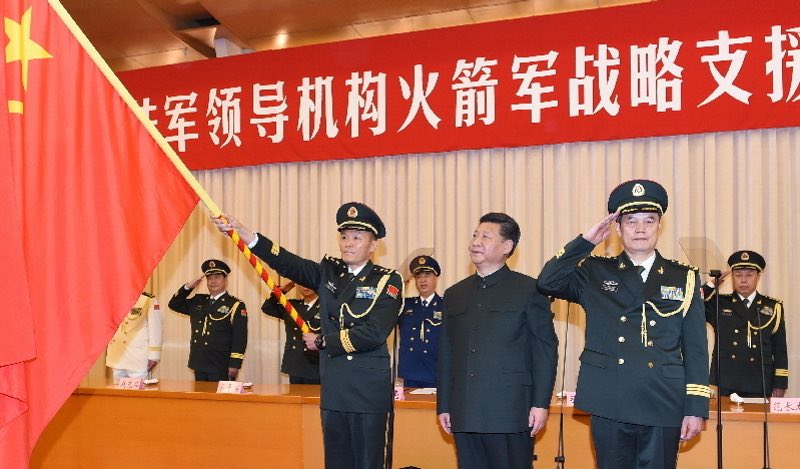 President Xi Jinping (center) transfers a military flag to Gao Jin (left) and Liu Fulian, commander and political commissar, respectively, of the PLA Strategic Support Force, at an inauguration ceremony in Beijing on Dec. 31. Credit: Chinese Ministry of National Defense Of the world’s 50 satellite laser ranging stations, five fixed stations are in Shanghai, Changchun, Beijing, Wuhan and Kuming
President Xi Jinping (center) transfers a military flag to Gao Jin (left) and Liu Fulian, commander and political commissar, respectively, of the PLA Strategic Support Force, at an inauguration ceremony in Beijing on Dec. 31. Credit: Chinese Ministry of National Defense Of the world’s 50 satellite laser ranging stations, five fixed stations are in Shanghai, Changchun, Beijing, Wuhan and Kuming
The Defense Intelligence Agency warned in January 2019 that China likely will field in 2020 a ground-based laser weapon that can counter low-orbit space-based sensors. By the mid-to-late 2020s it may field higher power systems that could damage the structures of non-optical satellites.
How real is the threat? Analysts have already identified five Chinese laser bases. One in Xinjiang has four main buildings. One of these building is thought to be for tracking satellites, while equipment in the other three could be used to dazzle or disable satellite sensors. If the Xinjiang facility is representative of the other four, all five bases can be located and are vulnerable to aerial attacks.
Beijing Launches a Global Assault on Free Speech
 The national security law imposed on Hong Kong by Beijing’s rubber-stamp, robotic National People’s Congress is the worst, most dangerous, and most overreaching law I have seen in over 25 years of human rights work. It is an all-out assault on freedom—not just in Hong Kong, but worldwide.
The national security law imposed on Hong Kong by Beijing’s rubber-stamp, robotic National People’s Congress is the worst, most dangerous, and most overreaching law I have seen in over 25 years of human rights work. It is an all-out assault on freedom—not just in Hong Kong, but worldwide.
Fast-tracked by Beijing over the course of a month, it shatters the promise that was made to Hong Kong at the handover almost exactly 23 years ago of a “high degree of autonomy” and—in the words of the last British governor of the city, Chris Patten—that “ Hong Kong people are to run Hong Kong..”
Hong Kong’s mini-constitution, known as the Basic Law, does require a national security law to be introduced at some stage. But it explicitly requires Hong Kong to do so “on its own.” Imposing a law from Beijing without even the pretense of a process in Hong Kong’s Legislative Council makes a total mockery of “one country, two systems.” Moreover, media reports suggest that Hong Kong’s Chief Executive Carrie Lam—a puppet of Beijing—did not even know that the law had been passed until she heard it from reporters and was in the dark about the content of the legislation until she signed it.
The law criminalizes four acts: subversion, secession, collusion with foreign entities, and terrorism.
China Wants to Be Lebanon’s Savior
Beirut’s Little China restaurant is the city’s most prominent establishment that serves authentic Chinese food, and it’s a regular gathering place for people of Chinese origin. It also serves as a symbol of China’s marginal role in Lebanese life more generally.
If Hassan Nasrallah, the chief of Hezbollah, has his way, that may soon change. Nasrallah recently declared in a televised speech that Lebanon must “look east” to China for its salvation at its present time of crisis. The implication was clear: Lebanon should not look to the International Monetary Fund. His Lebanese audience was left befuddled. The extent of crisis was evident—the country’s economy has nosedived, to calamitous effect, in recent weeks—but Lebanon, including some of its most reactionary conservatives, has always understood itself as an outpost of Western values and influence in the Middle East.
But Nasrallah is not alone among Lebanese policymakers in believing the country may soon have no choice but to enter China’s political and economic orbit. If that happens, political analysts say, it could mark a new and uncertain chapter in the country’s history.
Balancing act: Major powers and the global response to US-China great power competition
Fiona Hill
The world’s major powers are currently engaged in a careful balancing act when it comes to navigating the complex and ever-changing competition between the United States and China. This discussion focuses on the actors that have agency in this dynamic, and how each is approaching the escalation of U.S.-China rivalry.
The United States and China are now the world’s clear number one and number two in economic scale, energy consumption, carbon emissions, military spending, and technology. For most metrics indicative of relative international power, there is a substantial and growing gap between the top two powers (the U.S. and China) and the rest (with the exception of gross domestic product, if you consider the combined GDP of the European Union member states).
The countries discussed in this interview all have deep ties with both the United States and China. They are faced with increasingly difficult decisions regarding their current and future relations with both great powers. How are these countries attempting to cope, survive, and shape the rivalry, and to what extent are there commonalities or divergences of strategy across these issues?
In January 2020, Bruce Jones sat down with five other Brookings scholars — Fiona Hill, Tanvi Madan, Amanda Sloat, Mireya Solís, and Constanze Stelzenmüller — to discuss how U.S.-China rivalry is unfolding in India, Japan, the United Kingdom, the European Union (with a focus on Germany), Russia, and Turkey. In the interview, key areas of geopolitical competition, including technology, infrastructure development, trade, and sea power, are explored. The edited transcript below reflects their assessments.
Lone wolf: The West should bide its time, friendless China is in trouble
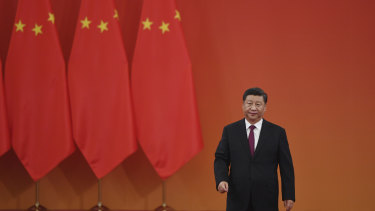 The ledger is brutally clear. Xi Jinping's regime has no allies of global economic weight or credibility.
The ledger is brutally clear. Xi Jinping's regime has no allies of global economic weight or credibility.
Some 53 countries backed China's treatment of Hong Kong in the UN Human Rights Council, a body now under the thumb of Beijing. They make up just 4 per cent of the world's GDP. Most are authoritarian statelets locked into the neo-colonial infrastructure nexus of China's "belt and road" initiative.
The only G20 member to have lined up on China's side was Mohammad bin Salman's Saudi Arabia, a struggling middle-income autocracy running out of places to sell its oil.
A lone wolf: Xi Jinping's China risks stalling long before it is rich. CREDIT:AP
The list offers a revealing view of the strategic order emerging in the early 2020s. The rich Western and Asian democracies, which still control the international economic system, are coalescing into a united front. China is starting to pay the exorbitant price for its wolf warrior diplomacy. Xi has given us a nasty foretaste of what the world will be like if the Communist Party ever attains global mastery.
This week he went so far as to extend extra-territorial jurisdiction of the Article 34 sedition law in Hong Kong to anybody, anywhere in the world. Professor Donald Clarke, from George Washington University, says the intent is simply "to put the fear of God into all China critics the world over".
Iran Under Attack – Analysis
By Neville Teller
Iranian media reported an explosion in western Tehran in the early hours of Friday, 10 July, causing electricity to be cut in surrounding suburbs. It was the latest in a string of mysterious blasts to rock the country. At least three are known to have occurred in or around Iranian nuclear facilities, and initial reports claimed that the latest explosion was at a missile depot belonging to Iran’s Islamic Revolutionary Guard Corps (IRGC). Occurring over some ten days, they cannot be easily explained away. The regime is undoubtedly under attack. The question so far unanswered is, from whom?
Is this a covert onslaught masterminded by Israel, the US, or the two acting in concert? Did Israeli F-35 fighters actually bomb one of the sites? Are a group of anti-regime activists, working within Iran’s nuclear industry, taking covert action to prevent the regime acquiring nuclear weapons? Were the incidents the result of sophisticated cyber attacks, or were they sabotage, caused by old-fashioned explosives? There is a great deal of speculation, but so far nothing definitive has emerged.
It was on June 26, 2020 that the first of this series of incidents occurred. Despite initial assertions by the Iranian Defense Ministry that there had been a minor detonation in the Parchin military complex, satellite images showed that it was at the nearby missile production complex at Khojir that a bomb had damaged a cache of gas tanks. The blast was later described as “a massive explosion” that had “burned a hillside”. Parchin, near Tehran, is where Western powers suspect Iran carried out tests related to nuclear warhead detonations more than a decade ago.
The Puzzle of U.S. Foreign Policy Revision Regarding Iran’s Nuclear Program
Sina Abolghasem Rasouli
This content was originally written for an undergraduate or Master's program. It is published as part of our mission to showcase peer-leading papers written by students during their studies. This work can be used for background reading and research, but should not be cited as an expert source or used in place of scholarly articles/books.
Foreign policy choices usually vary from historical decisions to everyday ones. Political front-runners make decisions to go to conflict, shape an alliance, reach an agreement, make peace, create diplomatic relations, apply a standpoint on nuclear non-proliferation or impose sanctions on other actors. Foreign policy decision making identifies the alternatives that individuals, groups, and coalitions choose which can affect a nation’s actions on the international level. These decisions are usually categorized by high stakes, massive ambiguity, and even substantial risk (Mintz, DeRouen, 2014). In that sense, the main aim of this short essay is to understand how the U.S. foreign policy, particularly during the beginning of Trump’s Administration, has been revised toward Iran’s nuclear program from the perspective of groupthink decision-making theory. To have thoughtful analysis, it is important to first briefly discuss the timeline of Iran´s nuclear agreement with world powers. Later on, this paper presents the concept of groupthink decision making within the context of the United States. The third section of this paper attempts to analyze the U.S. policy revision towards Iran’s nuclear program within the framework of the groupthink model. Finally, this paper concludes that the process of advocacy coalition and groupthink contestation at the beginning of Trump’s administration have played a role in the U.S. foreign policy towards Iran’s nuclear program.
Iran’s Nuclear Agreement
The US Needs a Global Coalition to Defeat COVID
BY JOSEPH VOTELFORMER, SAMUEL J. LOCKLEAR IIIFORMER
As our nation adapts to the challenge of the coronavirus at home, we must urgently confront the disruptive impacts of the pandemic around the world and the serious risks to our safety and national security. This will require forward thinking and U.S. leadership to mobilize our allies and partners around a comprehensive global health security response to a disease that does not recognize borders. Such an effort will save lives at home and around the world, protect and defend our national interests, and ultimately guarantee our way of life.
We cannot isolate ourselves from the impacts of this pandemic in a globally connected world. If America doesn’t lead, others will step into the void who bring a different vision for the world and one that does not reflect our values or our interests.
Confronting COVID-19 and strengthening our global health security is critical for our national security because what happens in other countries will undoubtedly echo back into our own. This will require strong leadership from Washington and resources that look at the challenges around the world that are coming — and coming quickly.
Following the 9/11 terrorist attacks, the United States led the vanguard of nations and international intelligence organizations. We built a network of allies and partners and intelligence sharing — even with others who may not always share all of our interests and values — to find terrorist havens, isolate them at their source, and diminish their impact. As a result, U.S. leadership in the global struggle against terrorism has kept our country safe since 9/11.
Can we avoid a lost decade of development?
Kevin Watkins
When governments gathered last September at the United Nations General Assembly, the talk was of a “decade of delivery” for the Sustainable Development Goals (SDGs)—the targets for eradicating extreme deprivation, expanding opportunities, and turning the tide on climate change. That was then. Now the world is teetering on the brink of unprecedented reversals in development. Can we stop the 2020s becoming a lost decade?
The answer to that question will have a profound bearing on a constituency often absent from the COVID-19 response debate. Children have not borne the brunt of the immediate health threats posed by the coronavirus pandemic. But as the pandemic mutates into a global economic crisis, millions of children could be left carrying disadvantages that will limit opportunities for the rest of their lives.
Poverty is one driver of the impending great reversal. The world was not on track for the 2030 goal of eradicating extreme poverty before COVID-19, and progress was slowing. We are now heading in the wrong direction. Based on national poverty lines, UNICEF and Save the Children estimate that the global downturn in economic growth could leave another 117 million children in destitution.
That figure is almost certainly an underestimate. Derived from economic growth projections, it takes no account of lockdown policies that have pushed millions of the near poor into poverty. Narendra Modi, India’s Prime Minister, apologized for the botched lockdown, which left millions of migrant workers and poor households without safety nets, food, or income; sadly, apologies don’t lift people out of poverty.
Guilt by Location
BY ADAM G. LICHTENHELD
The coronavirus pandemic has cast a light on the global displacement crisis and given governments an excuse to perpetuate it. Around the globe, 50 million people are internally displaced—the highest number in history—having been uprooted within their countries by conflict, violence, and disasters.
They join more than 30 million refugees and asylum-seekers who have crossed an international border to seek sanctuary in other countries. Displaced populations are particularly vulnerable to COVID-19. Yet government responses to the pandemic have worsened conditions in displacement camps and reception centers, encouraged the scapegoating of refugees and migrants, and limited access to asylum.
The potential for the coronavirus to exacerbate the suffering of the displaced, even as the United States and other countries increasingly restrict asylum, has renewed calls to focus on addressing the root causes of displacement.
People flee their homes for a variety of reasons—political, economic, social, and environmental. But armed conflict is a primary culprit. Wartime displacement is not just an unintended consequence of violence but also a deliberate strategy pursued by combatants. In a variety of countries that have been convulsed by civil wars and insurgencies in recent years—including Burkina Faso, Cameroon, Iraq, Myanmar, Nigeria, South Sudan, and Syria—armed groups have routinely and intentionally displaced civilians. It is thus critical to understand the strategic logic behind these actions. If any displacement crises are preventable, it is those that are intentionally created by political and military actors.
Six Ways the U.S. Isn't Ready for Wars of the Future
James Stavridis
Given the combination of Covid-19, economic turbulence and an election year, Americans can be forgiven if international security has been pushed out of mind. Congress, fortunately, has not been so distracted: The House Armed Services Committee last week passed a $740 billion annual defense authorization bill.
The measure addressed several hot-button issues specifically — a raise for the troops, Confederate symbols on bases, limiting the president's ability to pull out troops from Europe and Afghanistan. But the longer-term questions are murkier: What are the key areas in which the U.S. must invest to prepare for deterrence and combat operations in the 21st century?
There are plenty of very smart people looking at this question. Each of the armed forces has some version of a think tank wrestling with its future. The Army, for example, created the U.S. Futures Command in Austin, Texas — an excellent location given the confluence of tech and cyber companies, a major research university and a military-friendly state.
One dynamic group there, Team Ignite, is looking at how warfare will change in the 2040-2050 timeframe. This echoes work done at the RAND Corporation immediately after World War II in understanding how big technology changes can affect warfare. Team Ignite is trying to understand the fusion between artificial intelligence, biotech, space, machine learning and other trends. Another new effort is the Air Force’s Global Futures Report, which is both geopolitical and technological in its approach.
Angela Merkel Is Back
Everyone deserves a second chance, including German Chancellor Angela Merkel. After 15 years in office, she seems ready to tackle some unfinished business before stepping down next year. And Germany’s presidency of the Council of the European Union, which started on July 1 and will last six months, gives Merkel the chance to do so, particularly when it comes to improving her country’s tepid performance on curbing climate change, going digital, and promoting overall European unity.
It has been several years since the idea of German leadership was popular among its allies and past enemies alike. The country had bounced back relatively well from the 2008 financial crisis and was recognized for its adoption of renewable energy. Admiration for Germany grew, perhaps hitting a brief peak in 2015 thanks to its handling of that year’s refugee crisis, but since the last federal election in 2017, it had become apparent that Merkel and her country’s trademark policies were losing their shine.
Always governing from the middle in partnership with the center-left Social Democrats, Merkel left her country’s conservatives frustrated while also holding back on progressives’ ambitions for Eurobonds and tougher environmental regulations on industry. Meanwhile, Germany’s pursuit of what it called noble self-interest—whether it be the climate, innovation, or EU crisis management—had to some degree backfired and threatened EU solidarity.
Assessing Indian digital trade policies: Will they support a $5 trillion economy?
by Mark Linscott
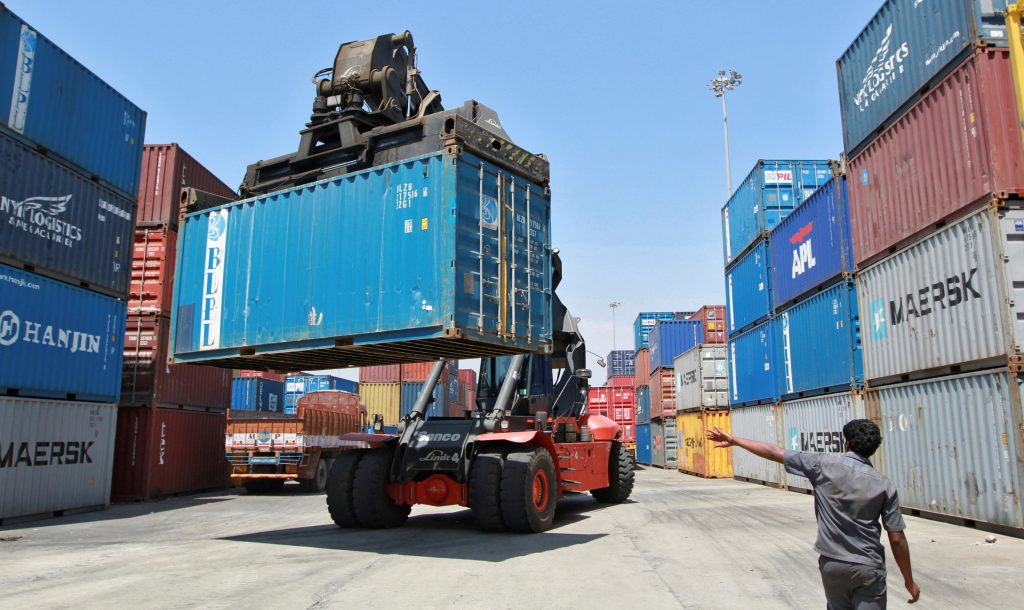 The ongoing COVID-19 pandemic has forced nearly all public policy questions to be seen through the lens of how to detect and respond to the disease as it spreads rapidly across the globe. These include obvious questions of national health care policy and whether there is a place for international efforts to coordinate their national responses. Trade policy has come to the fore as a growing number of countries restrict exports of critical medical supplies to ensure sufficient availability for patients in-country. In this crisis, international collaboration to keep trade flowing has been limited and has not prevented many countries from imposing new trade restrictions.
The ongoing COVID-19 pandemic has forced nearly all public policy questions to be seen through the lens of how to detect and respond to the disease as it spreads rapidly across the globe. These include obvious questions of national health care policy and whether there is a place for international efforts to coordinate their national responses. Trade policy has come to the fore as a growing number of countries restrict exports of critical medical supplies to ensure sufficient availability for patients in-country. In this crisis, international collaboration to keep trade flowing has been limited and has not prevented many countries from imposing new trade restrictions.
The importance of digital policies has grown as countries seek to harness the tools of big data, artificial intelligence (AI), and vital infrastructure to trace outbreaks of the virus and assist efforts to find cures and vaccines. While digital tools are proving vital in efforts to track outbreaks and trace contacts, legitimate concerns are growing about potentially invasive government surveillance even after the virus retreats.
Is the Polish Election a Choice Between Europe and the United States?
Jan Surotchak, Thibault Muzergues
 During a recent online debate hosted by the Warsaw-based publication Visegrad Insight, a Polish opposition figure commented that in the country’s presidential election, “Poles will have a choice to make between two models of society”—“a European Poland and a Poland that looks at the United States.”
During a recent online debate hosted by the Warsaw-based publication Visegrad Insight, a Polish opposition figure commented that in the country’s presidential election, “Poles will have a choice to make between two models of society”—“a European Poland and a Poland that looks at the United States.”
This remark encapsulates an increasingly common understanding of the dynamics at play in the election, which goes to a second and final round this Sunday. The conservative incumbent, Andrzej Duda of the ruling Law and Justice party, or PiS, will face off against his liberal challenger, Warsaw mayor Rafal Trzaskowski, who came in second to Duda in the first round of voting last month. ..
COVID-19 And Pandemics: The Greatest National Security Threat Of 2020 And Beyond – Analysis
By Robert E. Hamilton*
(FPRI) — How should the United States define its national security? At the U.S. Army War College, where I teach, that is one of the first questions we pose to our students. It’s not a simple one. While there is general agreement that national security includes protecting the territory of the United States and the lives of its citizens, securing agreement on more expansive definitions becomes challenging. Most students agree that economic prosperity is vital to national security. Some want to expand the definition further to include protection of key allies and partners, protection of values such as democracy and basic human rights, or upholding a world order that preserves stability. Of course, the more expansive the definition of national security, the greater the means required to protect it.
How a state defines national security helps it discern and defend against threats to that security. One of the next tasks we give our students is to articulate those threats and how the United States should defend against them. Here, the discussion usually revolves around a list of states—Russia, China, Iran, and North Korea inevitably come up. Discussion then usually moves to non-state threats, with international terrorism topping the list, followed often by proliferation of weapons of mass destruction and international organized crime. Some students argue that things like climate change and pandemic disease should be included on the list. Others argue that these non-traditional threats do not merit inclusion.
A New Chapter For Globalization – Analysis
By Chan Kung*
 Today, the world sees a heated discussion concerning the definition and significance of globalization on varying levels, and this leaves people at a loss. In British sociologist Anthony Giddens’ words, “modernity is inherently globalizing”, hence globalization can be understood as an expansion of modernity from the society to the world, so much so that any academicians who failed to discuss globalization in the past few decades are considered outdated and uninformed of current affairs.
Today, the world sees a heated discussion concerning the definition and significance of globalization on varying levels, and this leaves people at a loss. In British sociologist Anthony Giddens’ words, “modernity is inherently globalizing”, hence globalization can be understood as an expansion of modernity from the society to the world, so much so that any academicians who failed to discuss globalization in the past few decades are considered outdated and uninformed of current affairs.
Yet modernity itself is also subjected to change. What was once associated with modernity today may be “outdated” and “irrelevant” tomorrow, especially since the growing generation following WWII have built numerous theories and classics on the very concept of globalization, making such concept a classic consciousness. However, as time moves forward and the world enters a new development zone, we see that national policies are still rooted in sustainable development of globalization. On the other hand, globalization also faces major challenges and the phenomena of inverse-globalization, which causes the contradictions turning into violent, unrealistic struggles at times.
Currently, there are too many misleading perceptions and biases in the world towards globalization. How then, should we tread with globalization? How do we adapt to the huge challenges of inverse-globalization? These are some of the major issues begging to be answered.
The Strategic Logic of Russia’s Bounty Policy
By J. Dana Stuster
 On June 26, the New York Times reported that Russian military intelligence (known as the GRU) had paid bounties to the Taliban in exchange for Taliban fighters targeting and killing U.S. and coalition forces. Other news organizations quickly confirmed that U.S. military and intelligence agencies not only had obtained evidence of the program but also had been warning the Trump administration about the program for months. Much of the subsequent reporting has focused on the questions of what President Trump and his inner circle knew about the program and when they knew it. But less has been written about why Russia would take such a provocative step in the first place.
On June 26, the New York Times reported that Russian military intelligence (known as the GRU) had paid bounties to the Taliban in exchange for Taliban fighters targeting and killing U.S. and coalition forces. Other news organizations quickly confirmed that U.S. military and intelligence agencies not only had obtained evidence of the program but also had been warning the Trump administration about the program for months. Much of the subsequent reporting has focused on the questions of what President Trump and his inner circle knew about the program and when they knew it. But less has been written about why Russia would take such a provocative step in the first place.
Some of the reactions from U.S. policymakers to news about the bounty program have had a distinctly American perspective. One U.S. official cited in the New York Times speculates that the attacks are “revenge” for Russian casualties in an attack on a U.S.-held position in Syria, and that Russia is “keeping a score sheet, and they want to punish us for that incident.” Others have pointed to the involvement of the GRU in the scheme, given the GRU’s history of attacks targeting, among other things, the servers of the Democratic National Committee. It is hard to avoid these conclusions: The deliberate targeting of U.S. personnel is unavoidably about the United States.
But this reasoning ignores what Russia could hope to gain from encouraging the Taliban to target U.S. and coalition troops. The bounty program fits a pattern of Russian policy in Afghanistan rooted in Russia’s perceptions of its own national interest in maintaining influence in its near abroad. It may be a reprisal, but it is definitely strategic.
Cyber War Forthcoming: “It Is Not a Matter of If, It Is a Matter of When.”
Harriet Charlotte Turner
This content was originally written for an undergraduate or Master's program. It is published as part of our mission to showcase peer-leading papers written by students during their studies. This work can be used for background reading and research, but should not be cited as an expert source or used in place of scholarly articles/books.
A new security climate which encompasses threats beyond the realm of conventional warfare has brought about new challenges and new questions for strategy analysts. One question at the heart of the contemporary and complex security landscape remains; will cyber war take place or is it merely a sophisticated extension of sabotage, subversion and espionage? All three of which, as Thomas Rid (2012) emphasises, are certainly not new. The essay will stand in agreement with Rid by arguing that indeed, cyber war has not taken place in the past. However, it will proceed to argue that cyber war will take place in the future because cyber-attacks are likely to eventually meet the criterion necessary to constitute warfare. Thus, to claim otherwise as Rid has, is outdated, an ‘overly restrictive’ interpretation of what war is (Whetham, 2016. P.61) and underestimates the technological advancement in cyberspace. The essay will carry the idea that ‘it has not happened yet, but it will’ forward by cross-examining five crucial points which are as follows.
Firstly, it will argue against Rid where he claims that there is no force or direct violence involved in cyber-attacks that would render them acts of war. Secondly, it will tackle the most complex issues of all which are attribution, declaration and anonymity. Thirdly, it will challenge Rid’s distinction between sabotage and warfare by re-defining these boundaries and examining the Stuxnet attack as a plausibility probe by means of the equivalent-effects and Schmitt tests. Fourthly, it will argue that cyber-attacks do not need to be potentially lethal or involve physical injury or death to be considered acts of war. Lastly, it will argue that some cyber-weapons will have the capacity to damage all three areas which constitute the paradoxical trinity which can generate a strategic paralytic effect and ‘compelour opponent to fulfil our will’ (Clausewitz and Heuser, 2008, p.13). In summary, the essay will argue that cyber war will take place by dissecting and challenging Rid’s journal article and employing the work of scholars such as Amit Sharma, John Stone and David Whetham who constructed credible counter-arguments.
HOW STATES COULD RESPOND TO NON-STATE CYBER-ATTACKERS
The majority of cyber-attacks in the world are launched by non-state actors, especially criminals looking for money. Most of these cyber-attacks are far from advanced and have relatively little societal consequences. Yet, state actors increasingly also seem to hire non-state actors to launch more severe cyber-attacks with potentially damaging effects for societies abroad. While effectively responding to state-launched cyber-attacks is already a complicated task, this becomes even more difficult when states hide behind non-state actors.
How could states respond to non-state cyber-attackers, especially those aiming for large-scale operations harming their societies? This Policy Brief will briefly explore the problems in dealing with non-state cyber-attackers and will offer some policy options that are available. The benefits and risks of the policy options will be discussed as well, especially from a viewpoint of escalation risks.
US Leads In Artificial Intelligence, Says Pentagon Official
By C. Todd Lopez
When it comes to advancements in artificial intelligence technology, China does have a lead in some places — like spying on its own people and using facial recognition technology to identify political dissenters. But those are areas where the U.S. simply isn’t pointing its investments in artificial intelligence, said director of the Joint Artificial Intelligence Center. Where it counts, the U.S. leads, he said.
“While it is true that the United States faces formidable technological competitors and challenging strategic environments, the reality is that the United States continues to lead in AI and its most important military applications,” said Nand Mulchandani, during a briefing at the Pentagon.
The Joint Artificial Intelligence Center, which stood up in 2018, serves as the official focal point of the department’s AI strategy.
China leads in some places, Mulchandani said. “China’s military and police authorities undeniably have the world’s most advanced capabilities, such as unregulated facial recognition for universal surveillance and control of their domestic population, trained on Chinese video gathered from their systems, and Chinese language text analysis for internet and media censorship.”
Doom, Boom or Hibernation? Covid-19 and the Defense Industry
Johan Eriksson and Giampiero Giacomello
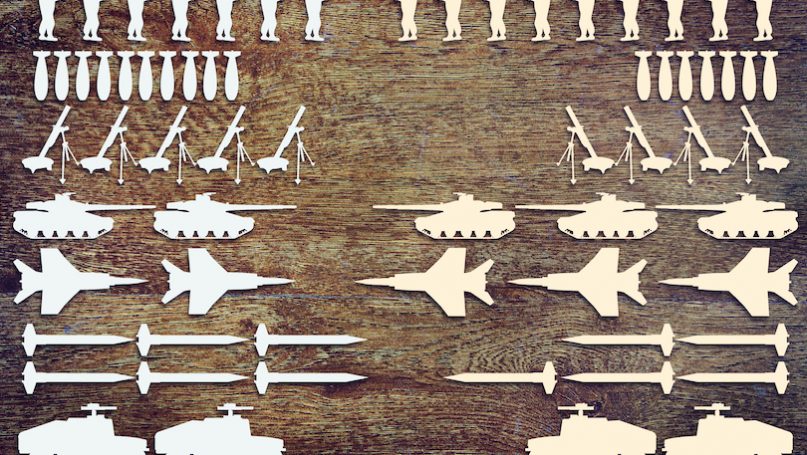 Undeniably, the general effect of the Covid-19 crisis on the global economy is very bad, implying widespread recession. Many observers, including the International Monetary Fund, believe the impact will be comparable to the Great Depression of the 1930s, if not worse. Global GDP is plunging, and trade and travel is hit particularly hard as borders were closed and national governments have responded to the pandemic in insular, if not isolationist ways. On a general, global level, defense spending and arms production have declined rapidly, following five years of straight growth. A recent poll shows that a large majority of defense companies – 69% – believe the impact of Covid-19 will be “hard” or “moderate”, while a remaining 31% of respondents believe the impact will be “low”. Early on, defense company stock prices declined rapidly, in some cases over 50% from February to March 2020. Importantly, however, effects of the Covid-19 crisis are not necessarily the same across the defense industry.
Undeniably, the general effect of the Covid-19 crisis on the global economy is very bad, implying widespread recession. Many observers, including the International Monetary Fund, believe the impact will be comparable to the Great Depression of the 1930s, if not worse. Global GDP is plunging, and trade and travel is hit particularly hard as borders were closed and national governments have responded to the pandemic in insular, if not isolationist ways. On a general, global level, defense spending and arms production have declined rapidly, following five years of straight growth. A recent poll shows that a large majority of defense companies – 69% – believe the impact of Covid-19 will be “hard” or “moderate”, while a remaining 31% of respondents believe the impact will be “low”. Early on, defense company stock prices declined rapidly, in some cases over 50% from February to March 2020. Importantly, however, effects of the Covid-19 crisis are not necessarily the same across the defense industry.
The aerospace sector has been hit particularly hard, with an almost complete shutdown of international traffic and transportation in the Spring of 2020. Military aerospace is not immune to this downturn, although air forces and other state-run aerospace organizations continue operations. Simultaneously, the capacity for rapid reaction and major campaigns is most likely considerably lower than under normal circumstances.
Military aerospace is to a degree sharing infrastructure with civilian aerospace – an effect of dual-use reforms, economy of scale-thinking, and national path-dependencies. Thus, when civilian aerospace crumbles, it has a negative impact also on defense, particularly in terms of infrastructural resilience. However, even if aerospace in general is in trouble, there are signs that military aerospace is affected to a lesser degree than its civilian counterpart, even within the same company. Boeing, for example, has had orders cancelled and has been forced to cut its workforce. Yet, Boeing also recently announced that its military branch for the first time in a decade will become bigger than its civilian side. The effects are reportedly similar across the aerospace community.
Subscribe to:
Posts (Atom)


